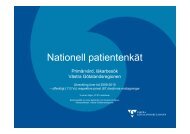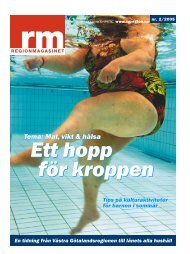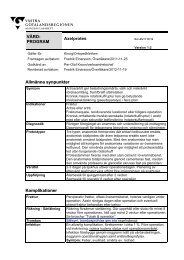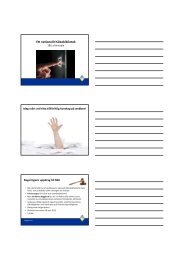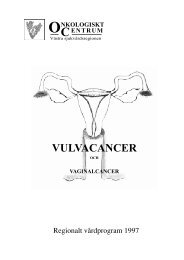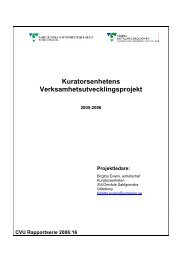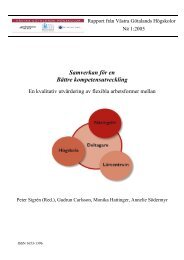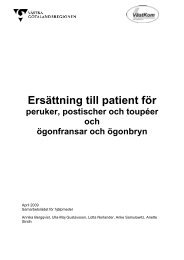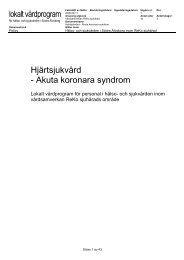FOURTEENTH ANNUAL EUROPEAN PRESSURE ULCER ...
FOURTEENTH ANNUAL EUROPEAN PRESSURE ULCER ...
FOURTEENTH ANNUAL EUROPEAN PRESSURE ULCER ...
Create successful ePaper yourself
Turn your PDF publications into a flip-book with our unique Google optimized e-Paper software.
Thursday September 1st<br />
Proceedings of the 14th Annual European Pressure Ulcer Meeting<br />
Oporto, Portugal<br />
Characterization of patients with pressure ulcers of the neurological clinical: a path to<br />
prevention<br />
Introduction<br />
Moura, E.C.C. 1* , Vasconcelos, I.C.M 2 , Caliri, M.H.L 3 , Silva, G.R.F 4<br />
1* Federal University of Piauí, Brazil elainecrism@bol.com.br<br />
2 Federal University of Piauí, Brazil<br />
3 University of São Paulo, São Paulo, Brazil<br />
4 Federal University of Piauí, Brazil<br />
Pressure Ulcers (PU) are a common problem of<br />
nursing practice. However, the complexity of risk<br />
factors and accurate assessment of them, numerous<br />
complications associated with these wounds, including<br />
the risk of death, among other problems as the<br />
demand of time and cost of hospitalization, all this<br />
make of the prevention and treatment of the PU a<br />
challenge for health professionals. In this context,<br />
evidence-based practice is indicated for a systematic<br />
care of quality. The objective of this study is raise the<br />
profile of neurological patients with pressure ulcers.<br />
Metodos<br />
This is a documentary study, descriptive and<br />
retrospective realized on the medical records of<br />
neurology clinical, in the period from 2008 to 2009, in a<br />
General Teaching Hospital in Teresina, Piauí, Brazil.<br />
After approval by the ethics committee and research<br />
institutions, the medical records were reviewed and<br />
among the 1175 records identified in that period, 46<br />
met the inclusion criteria: presence of UP registration.<br />
Results<br />
Table 1: Principal data on demographic characteristics<br />
of patients with PU. Teresina (PI), Brazil, 2010.<br />
Variáveis n %<br />
Sex<br />
Male 32 69,57<br />
Female 14 30,43<br />
Age<br />
< 20 2 4,35<br />
20-30 14 30,40<br />
31-40 7 15,22<br />
41-50 5 10,87<br />
51-60 7 15,22<br />
61-70 7 15,22<br />
71-86 4 8,70<br />
Marital Status<br />
Married 24 52,17<br />
Single 20 43,48<br />
Windower 2 4,35<br />
Total 46 100<br />
62<br />
Table 2: Principal data for the characterization of<br />
patients with UP.Teresina (PI), Brazil, 2010.<br />
Variáveis N %<br />
Referred from another hospital<br />
Yes 33 71,74<br />
No 13 28,26<br />
Presence of PU<br />
Hospitalization 30 65,22<br />
Admission 16 34,78<br />
Diagnosis<br />
Spinal cord injury 16 34,78<br />
Brain tumor 7 15,22<br />
Stroke 6 13,04<br />
Cerebral aneurysm 6 13,04<br />
Traumatic brain injury 6 13,04<br />
Hydrocephalus 3 6,52<br />
Syringomyelia and siringobulbia 1 2,17<br />
Guillain-Barre Syndrome 1 2,17<br />
Total 46 100<br />
Discussion<br />
There was a predominance of PU occurrence in young<br />
patients with principal diagnosis the spinal cord injury.<br />
This is because young patients with severe<br />
neurological deficit are susceptible, although 70% of<br />
PU occur in patients older than 65 years [1]. It is<br />
noteworthy the fact that 34.78% of patients being were<br />
admitted with PU and no records of the preventive<br />
actions to PU or application of risk assessment scales.<br />
It is known that early identification and treatment of PU<br />
allow a significant reduction in costs, and prevent its<br />
progress and accelerate the healing process [2]..<br />
Clinical relevance<br />
The knowledge of the profile of the patients with UP<br />
suggests that the results can be improved, it is<br />
important to implement more effective intervention,<br />
with the intention of alerting healthcare professionals<br />
about the importance of prevention strategies and<br />
interventions based on evidence since of the<br />
admission aiming at the safety to the neurological<br />
patient.<br />
References<br />
[1] Bluestein,D; Javaheri, A. Am Fam Physician.,<br />
78(10):1186-94,2008.<br />
[2] Brem, H; Lyder, C. Am J Surg., 188:9-17,2004.<br />
Copyright © 2011 by EPUAP



